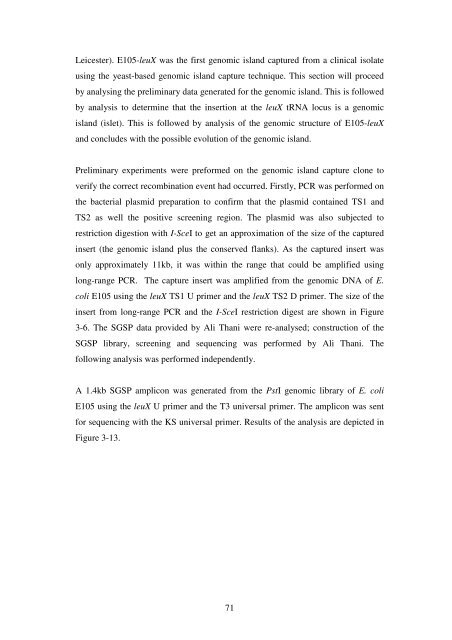5 The role of quorum-sensing in the virulence of Pseudomonas ...
5 The role of quorum-sensing in the virulence of Pseudomonas ...
5 The role of quorum-sensing in the virulence of Pseudomonas ...
Create successful ePaper yourself
Turn your PDF publications into a flip-book with our unique Google optimized e-Paper software.
Leicester). E105-leuX was <strong>the</strong> first genomic island captured from a cl<strong>in</strong>ical isolate<br />
us<strong>in</strong>g <strong>the</strong> yeast-based genomic island capture technique. This section will proceed<br />
by analys<strong>in</strong>g <strong>the</strong> prelim<strong>in</strong>ary data generated for <strong>the</strong> genomic island. This is followed<br />
by analysis to determ<strong>in</strong>e that <strong>the</strong> <strong>in</strong>sertion at <strong>the</strong> leuX tRNA locus is a genomic<br />
island (islet). This is followed by analysis <strong>of</strong> <strong>the</strong> genomic structure <strong>of</strong> E105-leuX<br />
and concludes with <strong>the</strong> possible evolution <strong>of</strong> <strong>the</strong> genomic island.<br />
Prelim<strong>in</strong>ary experiments were preformed on <strong>the</strong> genomic island capture clone to<br />
verify <strong>the</strong> correct recomb<strong>in</strong>ation event had occurred. Firstly, PCR was performed on<br />
<strong>the</strong> bacterial plasmid preparation to confirm that <strong>the</strong> plasmid conta<strong>in</strong>ed TS1 and<br />
TS2 as well <strong>the</strong> positive screen<strong>in</strong>g region. <strong>The</strong> plasmid was also subjected to<br />
restriction digestion with I-SceI to get an approximation <strong>of</strong> <strong>the</strong> size <strong>of</strong> <strong>the</strong> captured<br />
<strong>in</strong>sert (<strong>the</strong> genomic island plus <strong>the</strong> conserved flanks). As <strong>the</strong> captured <strong>in</strong>sert was<br />
only approximately 11kb, it was with<strong>in</strong> <strong>the</strong> range that could be amplified us<strong>in</strong>g<br />
long-range PCR. <strong>The</strong> capture <strong>in</strong>sert was amplified from <strong>the</strong> genomic DNA <strong>of</strong> E.<br />
coli E105 us<strong>in</strong>g <strong>the</strong> leuX TS1 U primer and <strong>the</strong> leuX TS2 D primer. <strong>The</strong> size <strong>of</strong> <strong>the</strong><br />
<strong>in</strong>sert from long-range PCR and <strong>the</strong> I-SceI restriction digest are shown <strong>in</strong> Figure<br />
3-6. <strong>The</strong> SGSP data provided by Ali Thani were re-analysed; construction <strong>of</strong> <strong>the</strong><br />
SGSP library, screen<strong>in</strong>g and sequenc<strong>in</strong>g was performed by Ali Thani. <strong>The</strong><br />
follow<strong>in</strong>g analysis was performed <strong>in</strong>dependently.<br />
A 1.4kb SGSP amplicon was generated from <strong>the</strong> PstI genomic library <strong>of</strong> E. coli<br />
E105 us<strong>in</strong>g <strong>the</strong> leuX U primer and <strong>the</strong> T3 universal primer. <strong>The</strong> amplicon was sent<br />
for sequenc<strong>in</strong>g with <strong>the</strong> KS universal primer. Results <strong>of</strong> <strong>the</strong> analysis are depicted <strong>in</strong><br />
Figure 3-13.<br />
71














